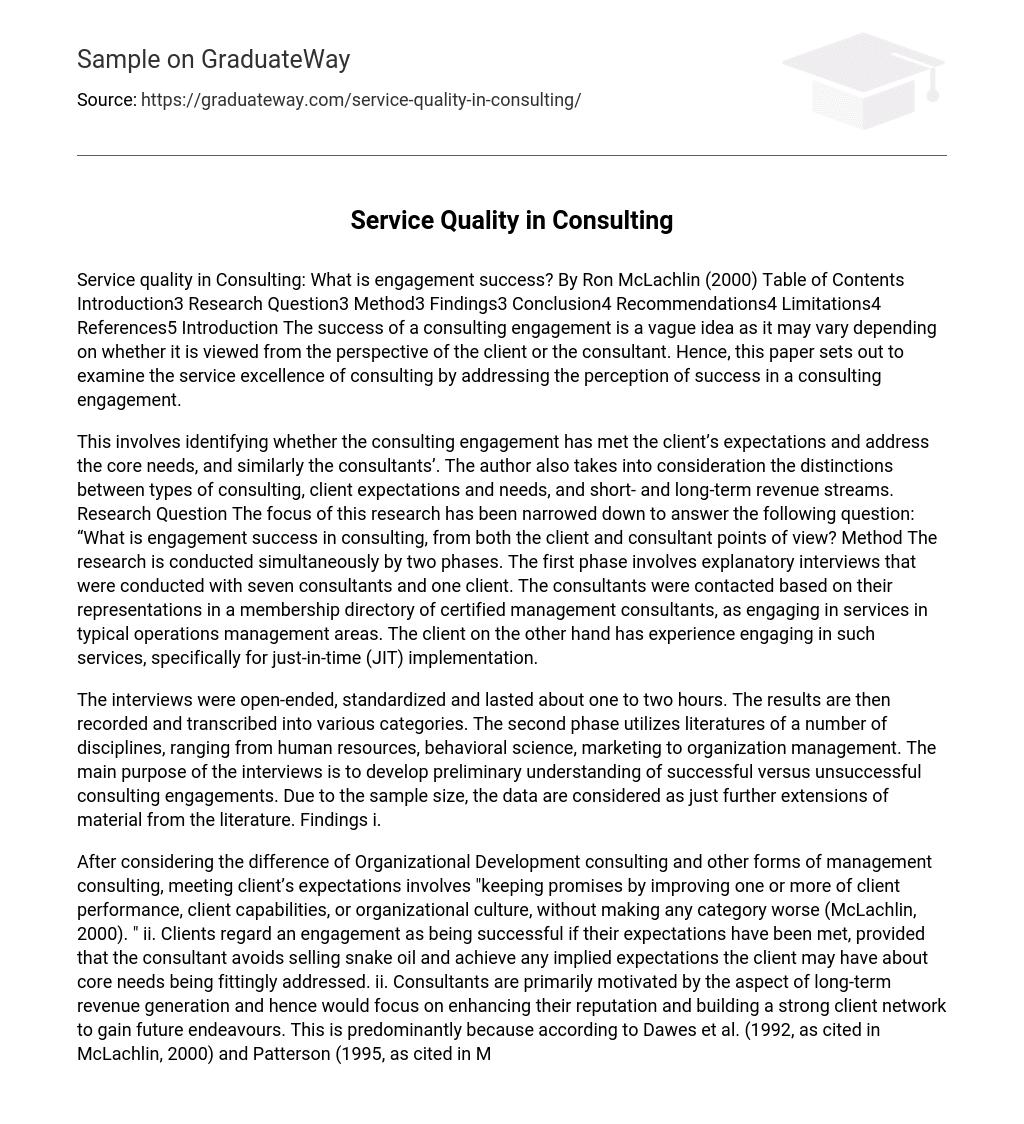Service quality in Consulting: What is engagement success? By Ron McLachlin (2000) Table of Contents Introduction3 Research Question3 Method3 Findings3 Conclusion4 Recommendations4 Limitations4 References5 Introduction The success of a consulting engagement is a vague idea as it may vary depending on whether it is viewed from the perspective of the client or the consultant. Hence, this paper sets out to examine the service excellence of consulting by addressing the perception of success in a consulting engagement.
This involves identifying whether the consulting engagement has met the client’s expectations and address the core needs, and similarly the consultants’. The author also takes into consideration the distinctions between types of consulting, client expectations and needs, and short- and long-term revenue streams. Research Question The focus of this research has been narrowed down to answer the following question: “What is engagement success in consulting, from both the client and consultant points of view? Method The research is conducted simultaneously by two phases. The first phase involves explanatory interviews that were conducted with seven consultants and one client. The consultants were contacted based on their representations in a membership directory of certified management consultants, as engaging in services in typical operations management areas. The client on the other hand has experience engaging in such services, specifically for just-in-time (JIT) implementation.
The interviews were open-ended, standardized and lasted about one to two hours. The results are then recorded and transcribed into various categories. The second phase utilizes literatures of a number of disciplines, ranging from human resources, behavioral science, marketing to organization management. The main purpose of the interviews is to develop preliminary understanding of successful versus unsuccessful consulting engagements. Due to the sample size, the data are considered as just further extensions of material from the literature. Findings i.
After considering the difference of Organizational Development consulting and other forms of management consulting, meeting client’s expectations involves “keeping promises by improving one or more of client performance, client capabilities, or organizational culture, without making any category worse (McLachlin, 2000). ” ii. Clients regard an engagement as being successful if their expectations have been met, provided that the consultant avoids selling snake oil and achieve any implied expectations the client may have about core needs being fittingly addressed. ii. Consultants are primarily motivated by the aspect of long-term revenue generation and hence would focus on enhancing their reputation and building a strong client network to gain future endeavours. This is predominantly because according to Dawes et al. (1992, as cited in McLachlin, 2000) and Patterson (1995, as cited in McLachlin), consultants are judged heavily on their reputation and the consulting industry relies heavily on a referral network (Maister, 1993 as cited in McLachlin, 2000).
Conclusion By comparing the viewpoint of both the client and consultant, the author defines “engagement success” as being achieved when “the client is satisfied that the consultant has met expectations regardless if the core address has been addressed – and the consultant is satisfied when his/her reputation has been enhanced, with the expectation of future income stream even if immediate income has not been received” (McLachlin, 2000). Recommendations
Firstly, as consultants we should assist clients in identifying their core needs and expectations because as stated by the author, “it is risky to ask a consultant both to determine one’s needs and to implement solutions. ” To do this, we could perhaps suggest clients to maintain an agenda list to ensure that each engagement delivers what they expect. Secondly, directly from the conclusion, we could draw out that we must be familiar with our own competencies and should only promise what we can deliver or similarly not take on an engagement if no values can be added.
Otherwise, long-term income would be jeopardised as we may risk not meeting client’s expectations. Lastly, once client’s expectations is identified and established, we should stay within the limited expectations and refrain from promoting any hidden agendas as addressing core needs without firstly meeting client’s expectation may result in an unstable client-consultant relationship. Limitations This paper is mainly limited by the research sample size. Firstly the overall sample size is relatively small.
This may arguably result in a skewed data that may only represent the local population and hence cannot possibly be indicative of the overall consulting industry. Secondly, as the number of clients interviewed is significantly less than the number of consultants interviewed, the data may or may not reveal enough information on behalf of the client, which could produce prejudiced views. Finally, as stated by the author, there could be further preconception in the interpretation of the interview data. References McLachlin, R. (2000). Service quality in consulting: what is engagement success? Managing Service Quality, 10(3), 141-150.





